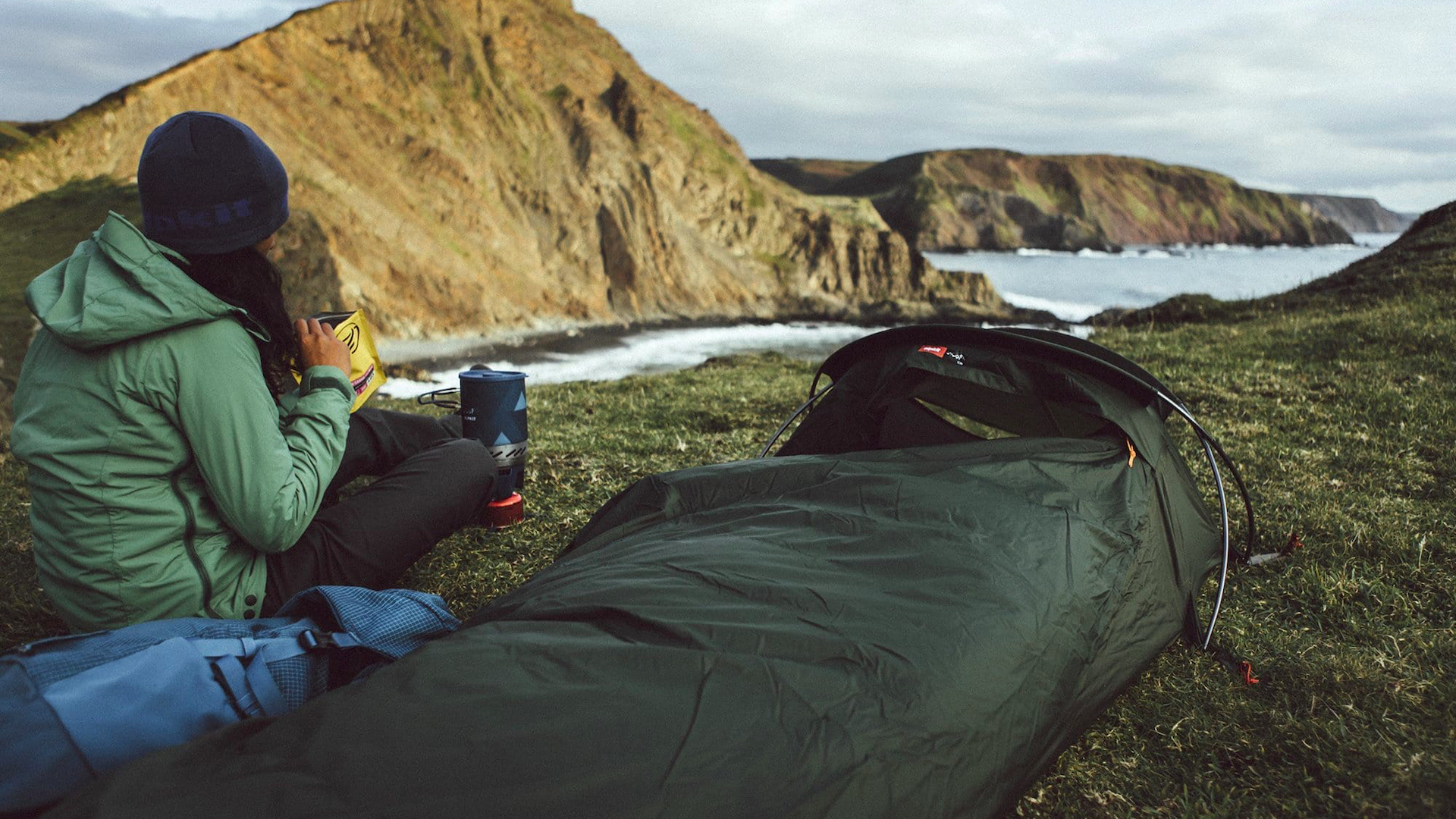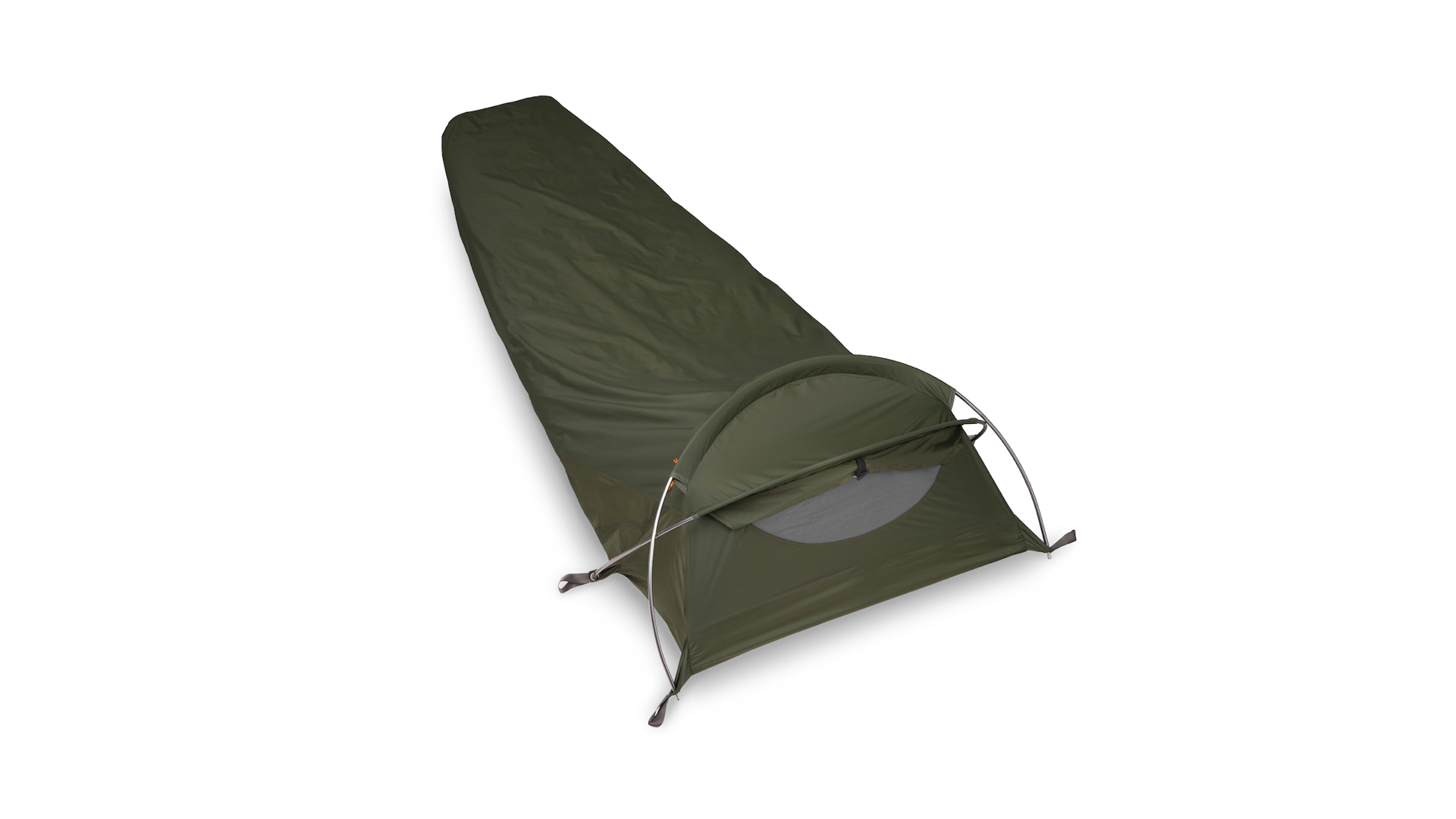Advnture Verdict
Almost tent-like in its features, the Elan still manages to keep the simplicity and lightweight qualities of a bivy sack.
Pros
- +
Free-standing or pegged-down hoop modes
- +
Side zip access
- +
Zip-closure insect and ventilation panel
Cons
- -
Extra features add weight
You can trust Advnture
Alpkit Elan: first impressions
The Alpkit Elan addresses the one drawback with bivy sacks – the lack of headroom – by using two lightweight crossed hoops to make a small domed space at the head end.
• RRP: $150 (US) / £110 (UK)
• Weight: 900g / 31.5oz
• Length: 225cm / 88.5in
• Width (shoulder & foot): 77cm & 74cm / 30.5in & 29in (plus 45cm / 18in in height)
• Materials: Top 70D coated nylon ripstop; bottom 70D coated nylon ripstop
• Mouth Closure: Single side and head zip
• Features: Free-standing hoops, peg points, side access zip, mosquito mesh
• Colors: Kelp Green
Although they add weight, the crossed hooped poles – which create a small “tent” at the head of the sack – add a large level of comfort to this sack, but it’s nowhere near as complex or heavy as a one-person tent.
The Elan allows you to prop yourself up on an elbow, without pushing your face against the fabric – a real luxury in the world of bivy sacks, especially on extended trips.
It’s a free-standing structure, with pegs and peg loops part of the package, keeping deployment rapid and easy. But Alpkit haven’t got carried away and added too many “tent” features, so the Elan retains the advantages of a low-weight bivy sack, but the ability to do basic non-sleeping camp tasks under shelter makes it suitable for multi-day – or week – trips in all but the most extreme of environments.
A mosquito net at face level and a mesh panel give good ventilation and help disperse condensation, though they can be closed off in bad weather. Lastly, a two-thirds-length side zip is a huge advantage when it comes to getting yourself, your sleeping bag and your sleeping pad into the sack.
Alpkit Elan: on the trails

Decades ago, I cycled a thousand miles around Iceland in wet May weather, using only an early Phoenix hooped bivy for shelter. It rained nearly every day and night. It wasn’t luxurious but I was fine. The Alpkit Elan employs the same idea, but hugely refined.
The two crossed hoops make the “igloo” above one’s head free-standing – though having nearly lost this sack in a gust of wind, I’d suggest that pegging it down in exposed sites is prudent. The space this gives one to read, eat, write up journals or indeed anything else that can be performed from a Roman-lying-on-a-couch position while being protected from whatever bad weather is thrown at you means this is a practical shelter for all kinds of lightweight, extended trips.
All the latest inspiration, tips and guides to help you plan your next Advnture!
The two-thirds length zip opening down one side and right around the hood rim not only gives easy access, but allows you to use the ground outside for preparing food or other tasks (just make sure it’s away from the prevailing weather when setting up).
At the hood end there’s a separate zipped mosquito net panel, and also another mesh ventilation panel at the hood’s extreme end with a drop-down flap; use these to keep airflow going through the sack to diminish condensation, as well as suspending the foot end skin from its handy loop where there’s a suitable branch above the sack.
The ability to lay out the Elan, stretch the head over the hoops and be inside shelter in under a minute convinced me that that it still has all the positives of a bivy sack with a few added tent comforts.
After a wild childhood in west Cork, Jasper Winn began embarking on long cycles, walks, horse journeys and kayak trips across five continents – adventures he’s decanted into books, magazine articles, radio and television documentaries. Keen on low-tech but good gear, Jasper is an advocate of slow adventures by paddle, pedal, saddle, boot and sail. He has circumnavigated Ireland by kayak and cycled across the Sahara. Twice. Having ridden north-to-south across Algeria he discovered the only way to get back was to turn round and pedal north again.


